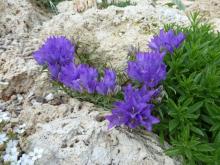I was told that Edraianthus do well here, and in my (albeit) brief experience with them, that seems to be true.
Edraianthus serbicus is a very showy one. Here's a plant in its second year from seed. Seeds were collected by M. Pavelka in the Konavska Hills, Bulgaria at 1400m elevation. Germination was straightforward and easy, with no seed treatment (e.g. stratification, scarification, GA-3) required; the seeds germinated at room temperature after about 10 days.
According to Graham Nicholls' Dwarf Campanulas (an excellent resource!), E. serbicus is endemic to a relatively restricted area of calcareous outcrops in western Bulgaria and eastern Serbia. Given its natural habitat on limestone substrates, my tufa bed (pictured) should be a fitting environment for it.
Its a very low-growing plant; even the flower stems in bloom stand no more than an inch or so above the ground surface. Here in this northern climate, the bloom occurs in late June and through July - a very nice addition to the rock garden, and probably a good choice for the beginner to try!




Comments
Lori S. (not verified)
Re: Some Edraianthus
Wed, 12/21/2011 - 7:18pmHere's Edraianthus dalmaticus, started from NARGS seedex seed in '09, and growing in a trough and in a non-calcareous crevice bed. This species, according again to Graham Nicholls, grows in screes in Montenegro and Serbia. This one was also easy from seed, with no seed treatment required.
This species has very different form than E. serbicus, being much more upright and reaching to about 5 inches tall in bloom in my conditions. The bloom time is about the same.
Trond Hoy
Re: Some Edraianthus
Wed, 12/21/2011 - 11:01pmLori, seems you are right regarding thriving Edraianthus at your place. I have tried some but they are always shortlived here. Maybe I should try at the mountain cabin ;)
John P. Weiser
Re: Some Edraianthus
Thu, 12/22/2011 - 6:15amCool plants. 8) You are doing something right they look very happy. :)
I like the mat forming species I have a few seedlings out in the garden and will be ordering seed of a couple of others from the exchange this year.
Lori S. (not verified)
Re: Some Edraianthus
Thu, 12/22/2011 - 9:51pmHere's another one that is rather similar to E. dalmaticus in general character and size, though the flower colour is a bit more vivid, at least on this individual... E. graminifolius, another denizen of limestone outcrops, from the Mediterranean to Eastern Europe (according again to Mr. Nicholls' excellent reference book):
It seems that this species has been in quite a state of flux between various genera - Edraianthus, Wahlenbergia, Campanula, Pilorea, Campanopsis... !
http://www.theplantlist.org/tpl/record/kew-369187
Trond Hoy
Re: Some Edraianthus
Fri, 12/23/2011 - 8:04amI like this one! It reminds me of a refined version of Campanula
cerviceacervicaria not unkommon here.From this site: http://verdalsbilder.no/cpg1410/displayimageNA.php?pos=-4146
Lori S. (not verified)
Re: Some Edraianthus
Fri, 01/13/2012 - 10:08pmIt just occurred to me that you might have meant Campanula cervicaria, Trond... ?
Trond Hoy
Re: Some Edraianthus
Fri, 01/13/2012 - 11:42pmYes, of course! Thank you Lori :o
Todd Boland
Re: Some Edraianthus
Mon, 01/16/2012 - 7:16amTrond, I grew a Campanula moesiaca that looks like your cervicaria...maybe a synonym name. Mine was lovely but alas, biennial and did not self-seed.
Edrianthus are short-lived here too.....essentially they are biennial...must be the wet climate we share Trond. Wish there were more alpines that could tolerate wet winters!
Trond Hoy
Re: Some Edraianthus
Mon, 01/16/2012 - 10:56amCould not agree more! I have seen "alpines" from high altitudes in the rainforests at the foot of several mountains but they dislike the cold :-\